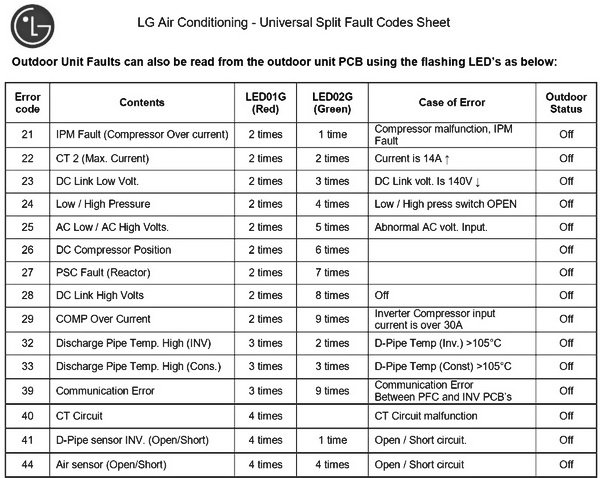
Error codes in appliances, like air conditioners, are similar to warning lights on a car’s dashboard. They’re designed to alert you when something isn’t quite right. Seeing an E1 error on your LG air conditioner might seem daunting at first, but it doesn’t spell disaster. Instead, it’s a call to action—to understand what’s causing the hiccup and how you can resolve it.
So, what exactly is the E1 error code, and how concerned should you be? Let’s dive into what this error code signifies and how you can navigate this issue.
Understanding the E1 Error Code on LG Air Conditioners
The E1 error code on an LG air conditioner is your unit’s way of notifying you that there’s a problem with the internal temperature sensor. Think of this sensor as the air conditioner’s “thermometer,” responsible for monitoring the temperature and ensuring that the unit cools effectively. When this sensor indicates an error, it could mean that it’s not reading the temperature correctly.
Now, you might be wondering why this is a problem. Well, imagine trying to drive a car without a speedometer. It would be difficult to know how fast you’re going or if you need to slow down. Similarly, if the air conditioner’s sensor issues incorrect readings, the unit might not cool your space efficiently. This can lead to discomfort and, in the worst cases, damage the unit over time if not addressed.
Fortunately, encountering an E1 error doesn’t mean your air conditioner is beyond repair. It’s more like a friendly nudge from your unit, telling you to take a closer look. The first step in addressing the E1 code is to confirm that the sensor is the root of the problem. Sometimes, simple fixes like checking for obstructions or ensuring the unit is properly ventilated can resolve the issue.
Is It Safe to Use the Air Conditioner With the E1 Error?
Here’s the deal: the appearance of an E1 error code might not mean your air conditioner is unsafe, but it certainly isn’t ideal to ignore it. Operating your air conditioner with an active E1 code can lead to inefficient cooling, which defeats the purpose of having the unit in the first place. If the air conditioner isn’t cooling properly, it may keep running without achieving the set temperature, leading to increased energy consumption and higher electricity bills.
Moreover, if the sensor genuinely malfunctions, the air conditioner might overcool the room or fail to shut off when needed, potentially leading to other mechanical issues. Think of it like wearing mismatched socks—it might not hurt you, but it’s not quite right either.
Therefore, your best bet is to address the E1 error sooner rather than later. If you’re unsure about tackling this yourself, don’t hesitate to contact a professional technician. They can accurately diagnose the problem and fix it, ensuring your air conditioner runs efficiently and safely.
Steps to Addressing the E1 Error Code
First things first, if you’re comfortable tinkering a bit, start by turning off the air conditioner and unplugging it for a few minutes. This simple reset can sometimes clear minor glitches, much like restarting a computer to resolve software issues. Once you plug it back in, check if the error code persists.
If the E1 error is still flashing, it’s time to delve deeper. Inspect the air filter and ensure it’s clean. A dirty filter can cause airflow issues, which might trigger errors. Additionally, make sure nothing is blocking the unit’s vents, as proper airflow is crucial for correct sensor readings.
If these checks don’t resolve the issue, it’s likely time to call in the pros. A certified technician will have the tools and expertise to take a closer look at the internal components, including the problematic sensor. They can confirm whether the sensor needs replacement or if a deeper issue is at play.
Preventative Measures to Avoid Future Error Codes
To keep your LG air conditioner in tip-top shape and avoid unexpected error codes, regular maintenance is key. Think of it like going for routine check-ups at the doctor; it helps catch potential problems before they become major headaches.
One of the simplest ways to maintain your air conditioner is by keeping the filters clean. Dust and debris can accumulate over time, leading to clogs that impair performance. A quick rinse of the filters every month can work wonders. It’s also important to ensure that the unit isn’t overworked. Giving your air conditioner breaks, especially at times when cooling isn’t crucial, can extend its lifespan and reduce the chance of errors.
Lastly, schedule professional maintenance at least once a year. Technicians can perform thorough inspections, clean internal parts, and spot any issues that might lead to future error codes. By keeping your air conditioner well-maintained, it’s more likely to provide reliable cooling without the interruption of pesky error codes.
In conclusion, while an E1 error code on your LG air conditioner isn’t cause for panic, it is your unit’s way of asking for a little TLC. By understanding what the code means and taking the right steps to address it, you can ensure your air conditioner continues to keep you cool and comfortable all summer long.